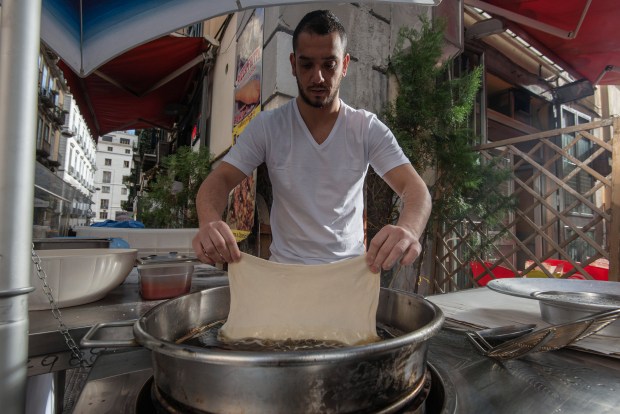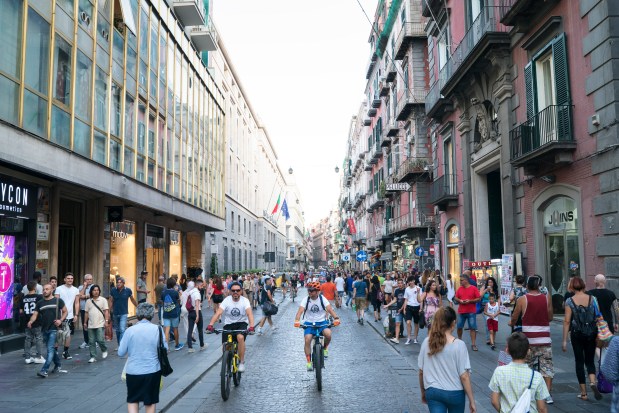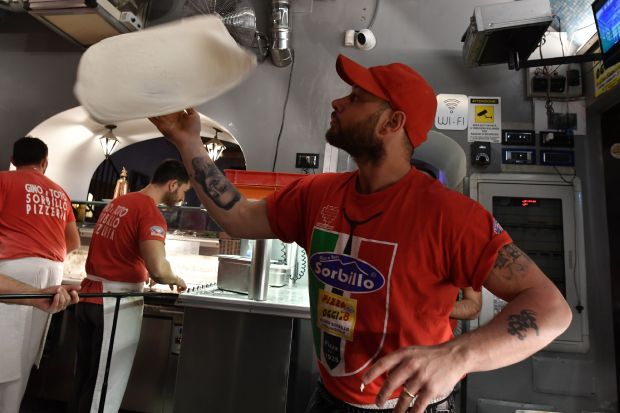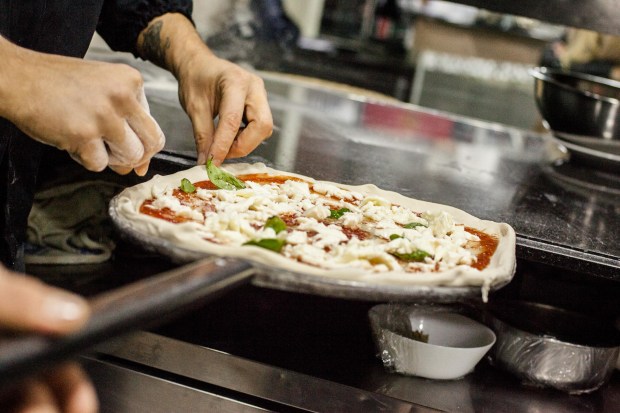NAPLES, Italy — Chicago is famed for its fabulously cheesy deep-dish pizza, but Naples, it is generally agreed, is where the savory thin-crust version of the pie was born.
My friend Therese and I, both former Chicago Tribune editors, decided we needed to visit Naples in search of the real deal during our trip to Italy. What we found was a vibrant city proud of its culinary roots and one where you could easily spend a week eating nothing but pizza in its many forms, though I never did spot deep-dish.
True Neapolitan pizza conforms to a long list of official regulations and is even represented by a lobbying group: The True Neapolitan Pizza Association, founded in 1984.
What goes into a classic? The association says it has to be round with a maximum diameter of 35 centimeters, which is just under 14 inches; use only four ingredients in its dough (flour, water, sea salt, brewer’s yeast) for a puffy, golden crust; use a light spread of San Marzano tomato sauce; add a sprinkling of chunks of buffalo-milk mozzarella, some grated cheese, fresh basil leaves and a drizzle of olive oil.
And it must be baked in a very hot wood-fired oven.
Beyond the technique, pizza evokes patriotism in Italy: Everybody boasts about their favorite pizza, and many say the red of the tomato, the white of the mozzarella and the green of the basil reflect the colors of the nation’s flag.
We arrived in Naples after a trouble-free, two-hour train ride from Rome and checked into our hotel with a rooftop view of a thankfully slumbering Mount Vesuvius in the distance. We set out the next morning to sample what the city had to offer, starting with a five-hour walking — or rather, eating — tour called the Culinary Secrets of Backstreet Naples.
Our guide, the Naples-born Francesca Russo, took us to several under-the-tourist-radar places to sample dishes such as flaky sfogliatelle pastry, salt-cod carpaccio and peppery octopus broth.
But the highlight of the tour was our final stop: Lombardi 1892, run by the fifth generation of pizzaioli, or pizza makers.

Here we sampled two types of Neapolitan pie: the famed pizza Margherita (named for an Italian queen who tried it and raved during a visit to the city in 1889) and the lesser-known, half-moon-shaped pizza fritta, fried pizza.
Of course pizza is much older than either of those examples. Archeologists recently found a 2,000-year-old fresco at Pompeii, near Naples, that depicts what might have been a cheeseless, tomatoless pizza.
“Pizza fritta started to spread especially just after World War II,” Russo said, “when the ingredients for the baked pizza weren’t available, together with the ovens, which often had been destroyed. So at first it was simply the disc of dough that was fried. Then with the passage of time, it was filled with ricotta cheese, black pepper cigoli (cubes of pork belly) and a little bit of tomato sauce.”

Those two pretty much covered the traditional side of things. So when I spotted the more contemporary menu at Salvo, I figured it was time to try something with a 21st-century twist. But would I like it?
Pizza topped with dollops of ricotta and dried seaweed? Sure. Smoked amberjack fish? Bring it on. It all adorned a pizza called L’Oceano, the ocean, for 12.50 euros.
Alas, I did not care for it, preferring the backup pizza I’d also ordered just in case — a Capricciosa, meaning capricious or whimsical. For 10 euros, this pie was covered with artichoke hearts and black olives alongside leaves of fresh basil, a few anchovies, bits of salami and grilled tomatoes. Its pillowy crust was perfectly charred in spots.
We walked off the meal on the stroll back to our hotel, past vendors hawking pizza-themed fridge magnets and bottle openers.
But that wasn’t the end of our brushes with crust. During our four days in Naples, we were never far from some type of pizza, including takeaway versions.

One evening, on a preprandial stroll down the pedestrian Via Toledo, we spotted a crowd of 20-somethings outside a tiny outlet of the Passione di Sofi street-food chain, placing orders for pizza a portafoglio, a wallet-style pizza. Made on the spot, it’s a round pizza folded in half and then in half again, sort of like a billfold, and wrapped in paper for a quick takeaway. Prices for the literally handy snack ranged from 2.50 to 3 euros — far cheaper than a sit-down experience.
One young woman in a black motorcycle jacket and trendy plaid scarf told me it was popular because it’s relatively inexpensive and you can eat it while walking down the street to meet your friends for a night out on the town.

Another popular takeaway style is pizza al taglio, which is sheet-pan pizza by the slice, though the slices are square or rectangular rather than New York-style triangular.
Across from our hotel on the Via Santa Maria di Costantinopoli, a storefront place called Tofi offered slabs of pizza with a basic marinara sauce for 1.50 euros and fancier options like a cherry tomato and olive combo or a potato and provolone mix for 3 euros.
One place we did not sample was L’Antica Pizzeria da Michele, perhaps the best-known pizza joint in Naples ever since Julia Roberts’ character pronounced “I’m in love” after taking a bite of her pizza Margherita in the 2010 film “Eat Pray Love.”
But of course everyone we met in Naples offered their own idea of who does it best.
One afternoon I took a quick side trip to the third-floor workshop of Omega gloves, a company founded in 1923, where the owner and chief executive, Alberto Squillace, was overseeing orders as a handful of women sat at sewing machines working colorful, fine leathers into shape.
As I selected two pairs of butter-soft gloves, the conversation inevitably turned to food. Specifically pizza. And more specifically, his favorite spot for true Naples pizza. His recommendation: the family-run Concettina ai Tre Santi.
But that one would have to wait for next time — Therese and I had a train to catch. It was time to leave Naples behind.
But not pizza.
Back in Rome, nearly at the end of our week in Italy, we had a serendipitous meet-up with pals, including another former Tribune co-worker.
I brought everyone to my favorite Roman spot famed for pizza: Ivo a Trastevere, where the pie was crispy, hot from the wood-burning oven. Could it be that the best pizza of the trip wasn’t even in Naples, but along a cobbled street in the Eternal City, made all the more delicious by the company of old friends?
Susanne Fowler is a freelance writer and editor.



